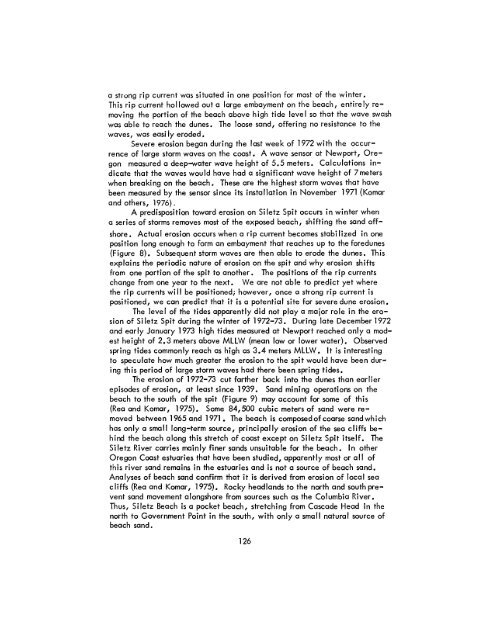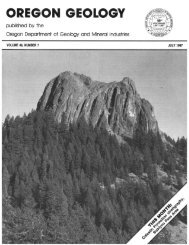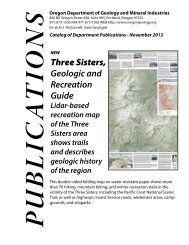The Ore Bin - Oregon Department of Geology and Mineral Industries
The Ore Bin - Oregon Department of Geology and Mineral Industries
The Ore Bin - Oregon Department of Geology and Mineral Industries
You also want an ePaper? Increase the reach of your titles
YUMPU automatically turns print PDFs into web optimized ePapers that Google loves.
a strong rip current was situated in one position for most <strong>of</strong> the winter.<br />
This rip current hollowed out a large embayment on the beach, entirely removing<br />
the portion <strong>of</strong> the beach above high tide level so that the wave swash<br />
was able to reach the dunes. <strong>The</strong> loose s<strong>and</strong>, <strong>of</strong>fering no resistance to the<br />
waves, was easi Iy eroded.<br />
Severe erosion began during the last week <strong>of</strong> 1972 with the occurrence<br />
<strong>of</strong> large storm waves on the coast. A wave sensor at Newport, <strong>Ore</strong>gon<br />
measured a deep-water wave height <strong>of</strong> 5.5 meters. Calculations indicate<br />
that the waves would have had a significant wave height <strong>of</strong> 7meters<br />
when breaking on the beach. <strong>The</strong>se are the highest storm waves that have<br />
been measured by the sensor since its installation in November 1971 (Komar<br />
<strong>and</strong> others, 1976).<br />
A predisposition toward erosion on Si letz Spit occurs in winter when<br />
a series <strong>of</strong> storms removes most <strong>of</strong> the exposed beach, shifting the s<strong>and</strong> <strong>of</strong>fshore.<br />
Actua I erosion occurs when a rip current becomes stabi lized in one<br />
position long enough to form an embayment that reaches up to the foredunes<br />
(Figure 8). Subsequent storm waves are then able to erode the dunes. This<br />
explains the periodic nature <strong>of</strong> erosion on the spit <strong>and</strong> why erosion shifts<br />
from one portion <strong>of</strong> the spit to another. <strong>The</strong> positions <strong>of</strong> the rip currents<br />
change from one year to the next. We are not able to predict yet where<br />
the ri p currents wi II be positioned; however, once a strong rip current is<br />
positioned, we can predict that it is a potential site for severe dune erosion.<br />
<strong>The</strong> level <strong>of</strong> the tides apparently did not playa major role in the erosion<br />
<strong>of</strong> Si letz Spit during the winter <strong>of</strong> 1972-73. During late December 1972<br />
<strong>and</strong> early January 1973 high tides measured at Newport reached only a modest<br />
height <strong>of</strong> 2.3 meters above MLLW (mean low or lower water). Observed<br />
spring tides commonly reach as high as 3.4 meters MLLW. It is interesting<br />
to speculate how much greater the erosion to the spit would have been during<br />
this period <strong>of</strong> large storm waves had there been spring tides.<br />
<strong>The</strong> erosion <strong>of</strong> 1972-73 cut farther back into the dunes than earlier<br />
episodes <strong>of</strong> erosion, at least since 1939. S<strong>and</strong> mining operations on the<br />
beach to the south <strong>of</strong> the spit (Figure 9) may account for some <strong>of</strong> this<br />
(Rea <strong>and</strong> Komar, 1975). Some 84,500 cubi c meters <strong>of</strong> s<strong>and</strong> were removed<br />
between 1965 <strong>and</strong> 1971. <strong>The</strong> beach is composed <strong>of</strong> coarse s<strong>and</strong> which<br />
has only a small long-term source, principally erosion <strong>of</strong> the sea cliffs behind<br />
the beach along this stretch <strong>of</strong> coast except on Siletz Spit itself. <strong>The</strong><br />
Si letz River carries mainly finer s<strong>and</strong>s unsuitable for the beach. In other<br />
<strong>Ore</strong>gon Coast estuaries that have been studied, apparently most or all <strong>of</strong><br />
this river s<strong>and</strong> remains in the estuaries <strong>and</strong> is not a source <strong>of</strong> beach s<strong>and</strong>.<br />
Analyses <strong>of</strong> beach s<strong>and</strong> confirm that it is derived from erosion <strong>of</strong> local sea<br />
cliffs (Rea <strong>and</strong> Komar, 1975). Rocky headl<strong>and</strong>s to the north <strong>and</strong> south prevent<br />
s<strong>and</strong> movement alongshore from sources such as the Columbia River.<br />
Thus, Siletz Beach is a pocket beach, stretching from Cascade Head in the<br />
north to Government Point in the south, with only a small natural source <strong>of</strong><br />
beach s<strong>and</strong>.<br />
126









